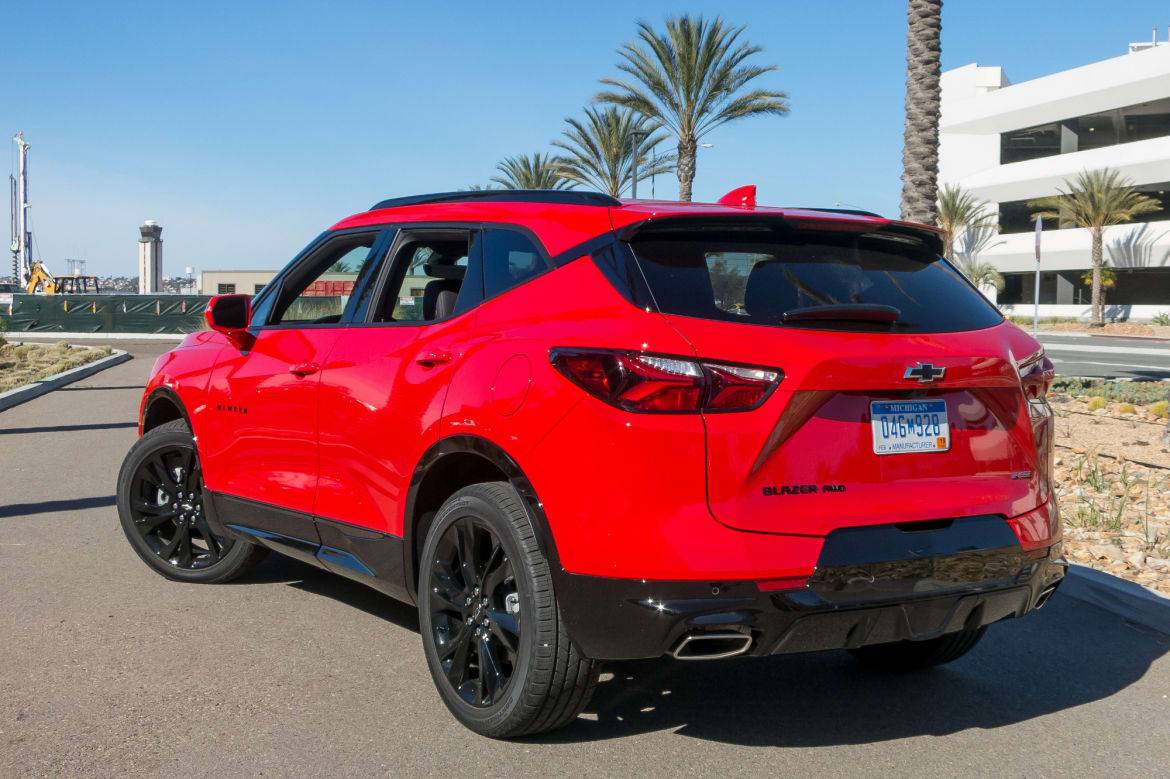What Real-World Gas Mileage Does the 2019 Chevrolet Blazer Get?


The hotly anticipated 2019 Chevrolet Blazer is arriving in showrooms very soon, and judging from the buzz surrounding Chevy’s stylish new two-row SUV, a lot of people are interested. It does have a lot to offer — from its dramatic, Camaro-inspired styling inside and out to the spacious passenger cabin and sport-inspired RS version, the Blazer seems well-positioned to go up against mid-size SUVs like the Nissan Murano, Hyundai Santa Fe, Ford Edge, Honda Passport and Jeep Grand Cherokee.
Related: 2019 Chevrolet Blazer First Drive: Going for Style Over SUVness
Blazin’ a Trail (to Chicago, on I-94)
While Chevrolet tells us styling is the top consideration for people shopping such pricey two-row SUVs, gas mileage is still a consideration for just about any shopper these days, and the field varies greatly in that area. Why? The variety of drivetrains in this category is wide, from basic four-cylinder engines to twin-turbo V-6s. I recently evaluated a new 2019 Chevrolet Blazer RS for around a week, and I drove the sucker from Ann Arbor, Mich., to the Windy City and back for the 2019 Chicago Auto Show. Equipped with the 308-horsepower, 3.6-liter V-6 that GM uses widely among its pricier models, it doesn’t lack for power. But what does this motor do over 600-plus miles in terms of efficiency?

The Blazer’s base engine, a 2.5-liter four-cylinder, is EPA-rated at 22/27/24 mpg city/highway/combined, and it’s available only in front-wheel-drive form (see how all Blazers are rated by the EPA here). The optional V-6 can come with front- or all-wheel drive; front-drive models are rated at 20/26/22 mpg, while AWD versions drop to 18/25/21 mpg.
My 617-plus miles with an AWD V-6 Blazer RS netted me a vehicle-calculated 21.3 mpg on average — decent but not stellar considering the vast majority of the distance was highway miles. But the calculated figure seemed optimistic: According to my fill-up receipts, the Blazer needed 35.122 gallons of gas to go those 617.9 miles, giving a decidedly less thrilling 17.6 mpg in calculated fuel economy.

Optimistic Trip Computer or Environmental Conditions?
Now, I should add that conditions were far from ideal for this test. The journey to and from Chicago occurred in subfreezing wintry conditions, with one leg done into a stiff 20-30-mph headwind. Such temperatures and conditions can affect everything from tire pressure to traction, so I’m not surprised the Blazer’s performance didn’t quite match its EPA rating. Its competition isn’t that much better, however: The top engine in the Ford Edge ST, which has standard AWD, gets 19/26/21 mpg (but boasts 110 pounds-feet more torque than the Blazer’s V-6), while the Nissan Murano V-6 AWD variant attains 20/28/23 mpg with its continuously variable automatic transmission. The Hyundai Santa Fe’s 2.0-liter turbocharged four-cylinder with AWD only gets 19/24/21 mpg, or slightly worse than the Blazer’s V-6.
More From Cars.com:
- Show Floor Face-Off: 2019 Chevrolet Blazer Vs. 2019 Honda Passport
- 2019 Chevrolet Blazer Video: Not Exactly the Blazer We Hoped For
- 2019 Chevrolet Blazer Pricing: Want AWD? Prepare to Pay Up
- Burn Book: Flaming (and Defending) the 2019 Chevrolet Blazer
- 2019 Chevrolet Blazer: Our Full Preview and Gallery
We’ll have to see what the Blazer does in better conditions to assess how it competes with the other stylish crossovers out there. We’re also curious to see how the FWD four-cylinder model works for fuel economy. We already know it’s fun to drive thanks to lighter weight and a peppy powertrain. All of it may be a moot point, anyway, given that styling is what sells these tall-wagon soft-roaders — and, increasingly, sporty on-road performance.
Cars.com’s Editorial department is your source for automotive news and reviews. In line with Cars.com’s long-standing ethics policy, editors and reviewers don’t accept gifts or free trips from automakers. The Editorial department is independent of Cars.com’s advertising, sales and sponsored content departments.

Detroit Bureau Chief Aaron Bragman has had over 25 years of experience in the auto industry as a journalist, analyst, purchasing agent and program manager. Bragman grew up around his father’s classic Triumph sports cars (which were all sold and gone when he turned 16, much to his frustration) and comes from a Detroit family where cars put food on tables as much as smiles on faces. Today, he’s a member of the Automotive Press Association and the Midwest Automotive Media Association. His pronouns are he/him, but his adjectives are fat/sassy.
Featured stories




